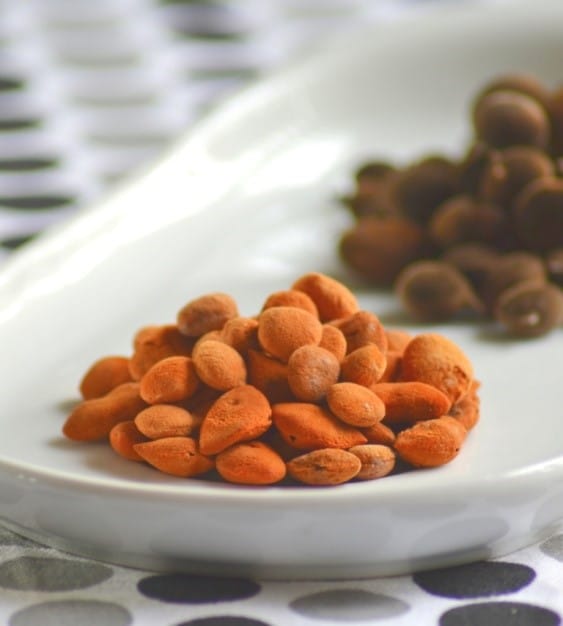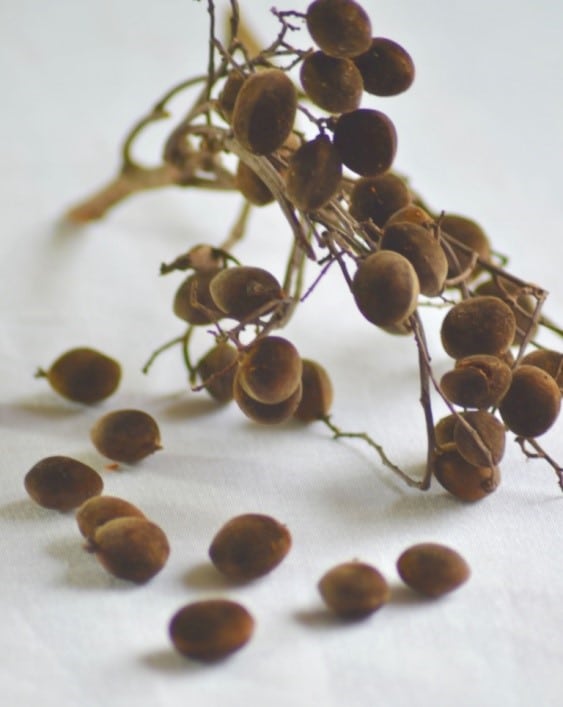The black velvet tamarind is the fruit of a native West African tree (Dialium guineense) cultivated not for its fruits but as a source of timber and fuel.
“Icheku”, “Ncheleku”, as this fruit is called by the Ibo people of south-eastern Nigeria, has an orange-colored pulp which has a sweet and sour taste and a dry powdery texture.

The fruit is also called “Awin” by the Yoruba, “Tsamiyar kurm” by the Hausa in Nigeria.
In Nigeria, Velvet tamarind is a very popular fruit snack, particularly among children, who peel the black velvet case to reveal an orange pulp that is eaten raw.

Nutritional Value of Velvet Fruit
According to Gnansounou et al (2014), Velvet tamarind has a potential for micro-nutrients.
(Gnansounou et al., 2014) Like the other fruits, it emerges that the fruit pulp of velvet tamarind is rich in minerals with interesting values.
- Iodine (04.34 ± 0.12 mg/100 g)
- Iron (14.75 ± 0.25 mg/100 g)
- Calcium (70.14 ± 10 mg/100 g)
- and Potassium (366 ± 0.26 mg/100 g).
The proximate composition of velvet tamarind fruit pulp using Bio-molecules analyzes has shown a high level of total carbohydrate(Gnansounou et al., 2014).
- Total carbohydrates (80 ± 1.8 g/100 g)
- Crude lipid (09.21 ± 0.50 g/100 g)
- Crude proteins (6.12 ± 0.33 g/100 g)
- Ascorbic acid (4.5 ± 0.01 mg/100 g)
- Moisture content (9.36 ± 1.36 g/100 g).
Health Benefits of Velvet Tamarind
- Treating Hypoglycemia (Low Blood Sugar): The high level of total sugars (80%) was in the range of the values published early and explains the fruit sweetened taste. The fruit is therefore indicated for children and people with hypoglycemia. The diabetics, on the other hand, should avoid some or limit consumption.
- High Antioxidant Power: Vitamin C content of the pulp was close to those (1.8 – 6.2 mg/100 g) returned in the literature (Eremosele et al., 1991). The fruit is a good source of vitamin C and its consumption can contribute to satisfying the journal requirement that is 90 to 110 mg. The importance of this vitamin resides otherwise in its antioxidant power (Masaki, 2010) inhibiting the ominous effect of free radicals on the DNA.
- Treats Scurvy and Treating of Infections: The fruit pulp has high ascorbic acid content (4.5 ± 0.01 mg/100 g) (Gnansounou et al., 2014) which is an anti-scurvy vitamin hence used as a food supplement. The high vitamin C content boosts the immune system and helps the body against infections. Also, see the health benefits of ginger and garlic
- Healing Wounds: The velvet fruit pulp has interesting content in calcium (70.14 ± 10 mg/100 g) and magnesium. Calcium participates in ossification, to the muscular contraction, and to the blood coagulation (Wardlaw & Smith, 2012). Coagulation, also known as clotting, is the process by which blood changes from a liquid to a gel, forming a blood clot. It potentially results in hemostasis, the cessation of blood loss from a damaged vessel, followed by repair. As for magnesium, it cooperates with calcium to the muscular contraction and blood coagulation. It is a cofactor for several enzymes (Rude, 2010).
- Combats Fatigue and Immunodeficiency: A food poor in C vitamin is associated with fatigue and immunodeficiency (Suh et al., 2012). The high vitamin C content boosts the immune system and prevents fatigue. Also, see the health benefits of ginger and garlic
- Repairs Blood Vessel and Combats Anemia: The velvet tamarind fruit pulp is rich in iron (14.75 ± 0.25 mg/100 g) (Gnansounou et al., 2014) . It is indispensable for iron absorption; cloves repair and blood vessel formation via collagen synthesis. The pulp’s iron absorption is more efficient because of the presence of vitamin C.
- Prevention or Treatment of Rheumatism and Type 2 Diabetes: Several works established its beneficial action in the treatment or prevention of rheumatism, type 2 diabetes (Afkhami-Ardekani & Shojaoddiny-Ardekani, 2007). High doses of ascorbic acid (2 g/day) have been shown to improve blood glucose regulation and reduce serum cholesterol and triglyceride in type 2 diabetes patients (Afkhami-Ardekani & Shojaoddiny-Ardekani, 2007). Also, see the health benefits of bitter kola
- Prevention of Hypertension: The values obtained for sodium and potassium of the velvet tamarind fruit pulp were respectively 76 ± 0.09 and 366 ± 0.26 mg/100 g (Gnansounou et al., 2014). Preliminary studies indicate that short-term potassium depletion also elevates blood pressure in hypertensive patients. Potassium supplementation lowers blood pressure in hypertensive patients ingesting normal amounts of sodium (Whleton & Cutler, 1997).
- Reliefs Menstrual Cramp and stops Diarrhoea: The stem bark extract has significant analgesic property hence, can be used to reduce menstrual pain. You can take it along with papaya leaf, salt, and water to work effectively. It can also stop diarrhea.
- Hemorrhoids (pile): Piles are swollen veins in the anal canal caused by too much pressure in the pelvic and rectal areas and while not life-threatening, these veins can be very painful. A study performed on ethanolic leaves extract of velvet tamarind showed it to be beneficial for pile treatment.
IF YOU FIND THIS ARTICLE TO BE USEFUL PLEASE LEAVE A FEEDBACK.
REFERENCE
- Afkhami-Ardekani, M., & Shojaoddiny-Ardekani, A. (2007). Effect Of Vitamin C On Blood Glucose, Serum Lipids And Serum Insulin In Type 2 Diabetes Patients. Indian Journal of Medical Research , 126(5), 471-4.
- Eremosele, I. C., Eremosele, C. O., & Kuzhkuzha, D. M. (1991). Evaluation Of Mineral Element And Ascorbic Acid Contents In Fruits Of Some Wild Plants. Plant Foods for Human Nutrition , 41(2), 151–154.
- Gnansounou, S. M., Noudogbessi, J., Yehouenou, B., Gbaguidi, A., Dovonon, L., Aina, M., Ahissou, H., & Sohounhloue, D. (2014). Proximate Composition and Micro-nutrient Potentials of Dialium guineense Wild Growing in Benin. International Food Research Journal , 21(4), 1603–1607.
- Masaki, H. (2010). Role Of Antioxidants In The Skin: Anti-Aging Effects. Journal of Dermatological Science, 58(2), 85–90.
- Rude, R. K. (2010). Magnesium. In Encyclopedia of Dietary Supplements (2nd ed., pp. 527–537). Informal Healthcare.
- Suh, S. Y., Bae, W. K., Choi, S. E., Jung, G. C., & Yeom, C. H. (2012). Intravenous Vitamin C Administration Reduces Fatigue In Office Workers: A Double-Blind Randomized Controlled Trial. Nutrition Journal , 11(7).
- Wardlaw , G., & Smith, A. (2012). Contemporary Nutrition, A Functional Approach (3rd ed.). Mc Graw-Hiller Science / Engineering/ Math.
- Whleton , P. K., & Cutler, J. A. (1997). Effects Of Oral Potassium On Blood Pressure: Meta-Analysis Of Randomized Controlled Clinical Trials. Journal of American Medical Association , 277(20), 1624–1632.



Can the juice of the fruit work same function as well?
Hi Priscilla, same also applies when you make a juice out of fruit pulp. But the quantity of nutrients you get when consumed raw would be different when made into juice.
It’s quite informative. Thanks
Very resourceful